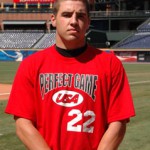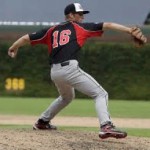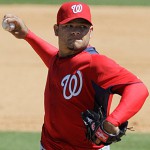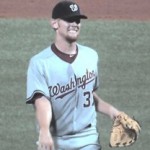Continuing a monthly series of look-backs at our starters (here’s Apr 2013 post), here’s a monthly glance at how our .500 team is doing from a Starting Pitching standpoint. As with last month, we’ll have “Grades” per outing, the team’s performance per opposing starter sliced and diced a few ways, and other per-starter stuff that I like to track.
MLB Rotation Per-Start Grades for May:
- Strasburg: C-,B-,A,A-,A+,C/inc
- Gonzalez: C+,A+,C+,A,D-
- Zimmermann: A+,A,A-,A,B+,D+
- Haren: A+,D+,A-,F,C+,B+
- Detwiler: C-,B,D-/inc -> D/L
- Duke: F
- Karns: D+
Discussion: Nats Pitcher YTD Stats from Baseball-Reference are here
Strasburg has stepped up his game after his well-documented 4-unearned run meltdown and has dominated his last three starts before straining his Lat on 5/31 (hence the “incomplete” grade). Gonzalez remains up-and-down, as he was in April/ He’ll be excellent and then less than mediocre start to start. Zimmermann‘s 6 run 7th in Baltimore is the only blip on an otherwise fantastic month which has put him into Cy Young contendor status. Haren‘s up and down starts finished off with a heroic effort in Baltimore on 5/30/13, pitching into the 8th and giving up just two runs to one of the more potent offenses in the league. Detwiler‘s month was cut-short by his injury and subsequent D/L trip. Lastly the Nats one known glaring weakness heading into this season (Starting pitching depth) has been exposed with the two spot starts we’ve gotten from Duke and Karns. I know Karns’ grade isn’t that fair considering the circumstances (MLB debut, hot night, tough hitting team), but his stat-line is what it is.
May Performance By Opponent Starting Pitcher Rotation Order Number
A look at the opposing team’s rotation ranked 1-5 in the order they’re appearing from opening day.
| Starter # | Record | Opposing Starter in Wins | Opposing Starter in Losses |
| 1 | 3-4 | Samardzija, Volquez, Hamels | Burnett, Kershaw, Cain, Hammel |
| 2 | 4-2 | Maholm, Rodriguez, Sanchez, Bumgarner | Jackson, Greinke |
| 3 | 2-3 | Medlen, Fister | Feldman, Stults, Tillman |
| 4 | 1-0 | Kendrick | |
| 5 | 3-1 | Locke, Beckett,Teheran | Vogelsong |
| 5+ | 2-3 | Smith, Gausman | Cashner, Pettibone, Garcia |
Thoughts; as always, not all opposing team #1 starters are the same. But, the Nats actually fared pretty durn well against opposing #1 and #2 guys in May. Where they struggled were against the #3 starters in May; you cannot lose to the likes of Scott Feldman, Eric Stults and Chris Tillman. They also struggled with what I call “5+” starters; guys who were call-ups to replace opening day starters. Sometimes a 5+ is a rising ace prospect (theoretically a Kevin Gausman or perhaps a Matt Harvey in the end of 2012) and sometimes they’re a 4-A guy (Jonathan Pettibone). But usually you expect a winning record there.
May Performance By Opponent Starting Pitcher Actual Performance Rank Intra-Rotation
A ranking of opposing teams’ rotations by pure performance at the time of the series, using ERA+ heavily.
| Starter # | Record | Opposing Starter in Wins | Opposing Starter in Losses |
| 1 | 1-3 | Bumgarner | Burnett, Kershaw, Cashner |
| 2 | 6-2 | Samardzija, Sanchez, Medlen, Fister, Kendrick, Locke | Greinke, Tillman |
| 3 | 3-2 | Maholm, Rodriguez, Beckett | Feldman, Pettibone |
| 4 | 1-3 | Teheran | Cain, Stults, Garcia |
| 5 | 2-3 | Volquez, Hamels | Hammel, Jackson, Vogelsong |
| 5+ | 2-0 | Smith, Gausman |
On the bright side; going 6-2 against the opposing team’s 2nd best starter isn’t bad.
May Performance By Opponent Starting Pitcher League-wide “Rank”
A team-independent assignment of a league-wide “rank” of what the starter is. Is he an “Ace?” Is he a #2?
| Starter # | Record | Opposing Starter in Wins | Opposing Starter in Losses |
| 1 | 1-3 | Hamels | Kershaw, Greinke, Cain |
| 2 | 4-0 | Bumgarner, Samardzija, Sanchez, Medlen | |
| 3 | 3-2 | Fister, Maholm, Volquez | Burnett, Tillman |
| 4 | 3-3 | Kendrick, Rodriguez, Beckett | Cashner, Hammel, Jackson |
| 5 | 4-5 | Locke, Smith, Gausman, Teheran | Feldman, Pettibone, Stults, Garcia, Vogelsong |
I like this table the best; It usually shows where a team really is over- or under-performing. There’s no shame in going 1-3 against the league’s best hurlers. And its fantastic to see the team going 4-0 against that collection of league-wide #2s. It is downright awful to see the team go 4-5 against this collection of #5 starters.
May Records by Pitching Advantage
Start-by-start advantages in my own opinion and then looking at the results.
| Wash | 9-5 | Strasburg-Hamels, Zimm-Maholm, Stras-Volquez, Zimm-Kendrick, Gonzalez-Rodriguez, Zimm-Beckett, Stras-Locke, Gio-Smith, Stras-Teheran | Zimm-Tillman, Gio-Hammel, Stras-Jackson, Gio-Feldman, Zimm-Stults |
| Even | 2-4 | Gonzalez-Bumgarner, Zimm-Sanchez | Strasburg-Cain, Detwiler-Burnett, Haren-Cashner, Haren-Garcia |
| Opp | 4-4 | Haren-Medlen, Karns-Gausman, Detwiler-Samarzija, Haren-Fister | Haren-Kershaw, Detwiler-Greinke, Haren-Pettibone, Duke-Vogelsong |
In other words, the team when 9-5 when I thought Washington had the pitching advantage, 2-4 when I thought the pitching matchup was even, and 4-4 when I thought the opposing team had the advantage. This is about what I expected, perhaps wanting to see a slightly better record in our advantage’d starts. The Strasburg-Edwin Jackson loss hurt, as did the Zimmermann-Stults loss.
May matchup analysis
Looking at the opposing starter rank that our guys are going up against to see how their competition fares.
| Nats Starters Opponents | matchup analysis | Nats Record under starter | |
| Strasburg | Three #1s, One #2, Two #5s | 4-2 | |
| Gonzalez | One #1, Two #2s, a #3 and a #5+ | 3-2 | |
| Zimmermann | Two #2s, Two #3s, a #4 and a #5 | 4-2 | |
| Haren | One #1, Two #3s, and Three #5+ | 2-4 | |
| Detwiler | Two #1s, One #2. | 1-2 | |
| Duke | One #5 | 0-1 | |
| Karns | One #5+ | 1-0 | |
| total record | 15-13 | ||
Detwiler’s turn now basically matches up with the opposing teams’ best guys, while Haren is getting more and more #5 and #5+ guys but continues to struggle.



